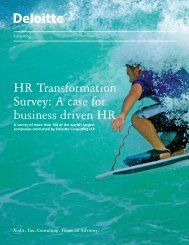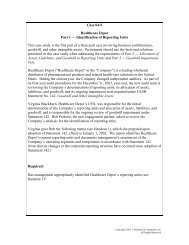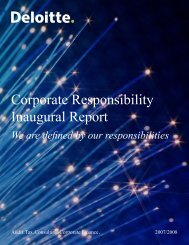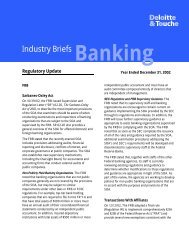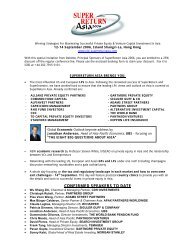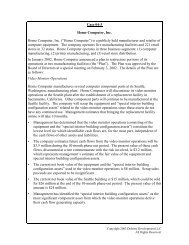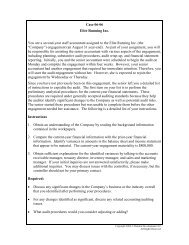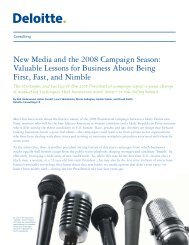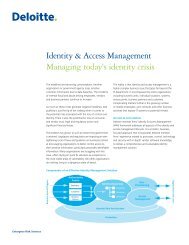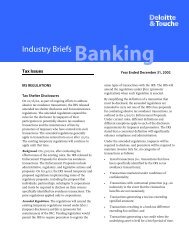Taking HR to the next level - Deloitte
Taking HR to the next level - Deloitte
Taking HR to the next level - Deloitte
- No tags were found...
Create successful ePaper yourself
Turn your PDF publications into a flip-book with our unique Google optimized e-Paper software.
Consulting<strong>Taking</strong> <strong>HR</strong> <strong>to</strong><strong>the</strong> <strong>next</strong> <strong>level</strong>A structured approach <strong>to</strong>developing and executingan effective <strong>HR</strong> strategy
Table of contentsExecutive summary 1A roadmap for <strong>HR</strong> strategy 2Define value 31. Understand business strategy 42. Define <strong>HR</strong> strategy 53. Identify <strong>HR</strong>’s primary performance levers 6Align <strong>HR</strong> services 74. Segment stakeholders 85. Prioritize <strong>HR</strong> investments 96. Design <strong>HR</strong> services 10Deliver value 117. Establish a delivery model for <strong>HR</strong> services 128. Upgrade <strong>the</strong> company’s <strong>HR</strong> capabilities 139. Continuously improve <strong>HR</strong> operations 1410. Communicate <strong>the</strong> value of <strong>HR</strong> services 15Case Study: Creating competitive advantage through <strong>HR</strong> strategy 16Putting it all <strong>to</strong>ge<strong>the</strong>r 18Contact information 19
A roadmap for <strong>HR</strong> strategyIn <strong>the</strong> past, <strong>HR</strong> was viewed primarily as an administrative function and its strategies were fairly simple.But now, perception has changed. Today, most companies recognize that people are vital <strong>to</strong> everyaspect of business performance and <strong>the</strong> <strong>HR</strong> function needs a sound strategy <strong>to</strong> provide services thatsignificantly enhance <strong>the</strong> value of this critical resource.Of course, developing a clear and robust <strong>HR</strong> strategy is just <strong>the</strong> beginning. In <strong>the</strong> end, achieving<strong>the</strong> desired results of any strategy hinges on effective execution. The following framework outlines<strong>the</strong> 10 major steps we believe are necessary for developing and executing an effective <strong>HR</strong> strategy.Although <strong>the</strong> specific approach varies from one situation <strong>to</strong> <strong>the</strong> <strong>next</strong>, we believe this generalframework can help any <strong>HR</strong> function develop and deliver <strong>the</strong> kinds of services and capabilitiesthat <strong>to</strong>day’s companies need <strong>to</strong> survive and grow.Figure 1: <strong>Deloitte</strong> <strong>HR</strong> Strategy FrameworkAlign <strong>HR</strong> Services1. Understand business strategy4. Segment stakeholders2. Define <strong>HR</strong> strategy3. Identify <strong>HR</strong>’s primarypeformance leversDefine Value<strong>HR</strong>Strategy5. Prioritize <strong>HR</strong> investments6. Design <strong>HR</strong> servicesDeliver Value7. Establish a delivery model for <strong>HR</strong> services8. Upgrade <strong>the</strong> company’s <strong>HR</strong> capabilities9. Continuously improve <strong>HR</strong> operations10. Communicate <strong>the</strong> value of <strong>HR</strong> services2
Define valueThe first step <strong>to</strong>ward an effective<strong>HR</strong> strategy is <strong>to</strong> define“value” and <strong>to</strong> understand howbusiness value is created. Thisrequires deep insights in<strong>to</strong> <strong>the</strong>overall business environment —including general market forcesand trends — as well as a clearunderstanding of <strong>the</strong> company’soverall business strategy. In fact,<strong>HR</strong> strategy is most effectivelydeveloped as an integral part ofbusiness strategy — taking in<strong>to</strong>account workforce trends andhow <strong>HR</strong> can help <strong>the</strong> companycreate value. If this is not doneat <strong>the</strong> outset, individual businessunits are likely <strong>to</strong> develop <strong>the</strong>irown <strong>HR</strong> strategies, leading <strong>to</strong>duplication of effort, potentialconfusion among managers andstaff, and higher <strong>HR</strong> costs.3
1. Understand business strategyUnderstand cus<strong>to</strong>mer needs, market forces, and trends. Model <strong>the</strong>ir impac<strong>to</strong>n resource planning and workforce performance.Understand business strategy and strategic priorities. Plan and model <strong>the</strong>impact on resource planning and workforce growth.Understand <strong>the</strong> implications of <strong>the</strong> overall business strategy and marketenvironment on governance, compliance, and risk.Different business strategies require different workforce strategies.How a company chooses <strong>to</strong> compete — and <strong>the</strong> current and projectedstrengths and weaknesses of its talent pool — will largely dictate <strong>the</strong>kinds of human capital investments and actions necessary <strong>to</strong> achievedesired results in <strong>the</strong> marketplace. For example, a strategy based oninnovation has different workforce requirements than a strategy basedon outstanding cus<strong>to</strong>mer service <strong>level</strong>s or low prices. Similarly, anorganic growth strategy requires very different people practices thanan aggressive growth strategy based on mergers and acquisitions.A company’s <strong>HR</strong> strategy, just like its overall business strategy, mustbe grounded in a solid understanding of market forces and trends.In developed countries, demographic trends, such as Baby Boomerretirements, aging workforces, and a declining interest in science andtechnology education, are creating a chronic shortage of critical talent.At <strong>the</strong> same time, <strong>the</strong> labor pool is becoming increasingly global,driven by new workplace practices and technologies that make itpossible <strong>to</strong> tap talent pools that were previously inaccessible.In addition, actions taken by cus<strong>to</strong>mers, competi<strong>to</strong>rs, and supplierscan have a big impact on a company’s workforce requirements. Forexample, as competition in <strong>the</strong> telecommunications industry continues<strong>to</strong> squeeze profits, companies are steadily shifting <strong>the</strong>ir operations <strong>to</strong>lower-cost offshore locations. Similarly, in <strong>the</strong> technology sec<strong>to</strong>r, <strong>the</strong>emergence of high-profile companies is forcing incumbents <strong>to</strong> findnew ways <strong>to</strong> attract and retain <strong>to</strong>p talent.When developing an <strong>HR</strong> strategy, all of <strong>the</strong>se forces and trends mustbe fac<strong>to</strong>red in<strong>to</strong> <strong>the</strong> equation. Figure 2 shows a simple, but effectiveframework <strong>to</strong> help <strong>HR</strong> align its strategies and capabilities with <strong>the</strong>strategies and priorities of <strong>the</strong> company.Figure 2: Aligning <strong>HR</strong> with <strong>the</strong> Company (case study):CEO PerspectiveBusiness StrategyBusiness Plan• Scale and scope for a consolidatingtelecommunications industry• Innovation leader delivering comprehensiveportfolio of products, services and solutions• Unique position <strong>to</strong> compete effectivelyagainst competition• Achieve €1.5Bn cost synergies by 2010• Double digit operating margin in <strong>the</strong> first year• Drive savings and targets• Regula<strong>to</strong>ry and reporting compliance• Talent retention<strong>HR</strong> Strategy• Aid transition and enable business <strong>to</strong> achievestrategic goals and targets• Uncertainty from rapid changes• Reducing costs and increasing revenue whileretaining talent• Reducing IT and business complexity andredundancy<strong>HR</strong> Business Plan• An efficient, effective, flexible and compliant<strong>HR</strong> that provides integrated service delivery• An <strong>HR</strong> cost structure that supports expansionin<strong>to</strong> low cost countries• An <strong>HR</strong> Service Delivery Model <strong>to</strong> handle M&A,downsizing or <strong>the</strong> acquisition of groups ofemployeesC<strong>HR</strong>O PerspectiveSource: <strong>Deloitte</strong> Consulting strategic analysis for a telecommunications client.4
2. Define <strong>HR</strong> strategyDetermine <strong>the</strong> most effective ways <strong>to</strong> attract, motivate, develop, and retain newand existing talent given <strong>the</strong> business environment.Define a set of key people initiatives <strong>to</strong> support <strong>the</strong> overall business strategy.Develop guidelines and approaches for governance, compliance, and risk mitigation.An effective <strong>HR</strong> strategy provides a roadmap for creating valuethrough <strong>the</strong> company’s workforce. It also includes guidelines that<strong>the</strong> company will follow when competing for new talent or trying<strong>to</strong> retain existing talent. These guidelines can cover a broad rangeof issues, such as which skills and competencies are most critical forachieving future goals and objectives, how <strong>to</strong> source talent (grow orbuy), and how <strong>to</strong> create and maintain a high-performance culture.The latter might include insights about <strong>the</strong> types of behaviors <strong>to</strong>be rewarded, <strong>the</strong> appropriate mix of monetary and non-monetaryincentives, and how <strong>to</strong> handle underperforming employees.Of course, it is very difficult for a company <strong>to</strong> be good at everything.The key <strong>to</strong> developing an effective strategy is deciding what <strong>to</strong> focuson — and what <strong>to</strong> ignore. An effective <strong>HR</strong> strategy defines a smallset of initiatives that are critical <strong>to</strong> <strong>the</strong> overall business strategy. It alsodescribes <strong>the</strong> types of products and services associated with <strong>the</strong>secritical initiatives — for example, compensation and training — andprovides a broad outline for how <strong>the</strong>se products and services will bedelivered.<strong>Deloitte</strong> Enterprise Value Map for Human Capital (figure 3) shows<strong>the</strong> link we see between specific human capital dimensions (such asworkforce planning, rewards, compliance, change management, andleadership development) and key business drivers (revenue growth,operating margin, asset efficiency, and expectations). This typeof analysis can help company leaders understand <strong>the</strong> relationshipbetween business strategy and <strong>HR</strong> and make it easier <strong>to</strong> develop an<strong>HR</strong> strategy that aligns with <strong>the</strong> needs of <strong>the</strong> company (figure 3).A comprehensive <strong>HR</strong> strategy also incorporates a view of <strong>the</strong>company’s people-related risks in operations, reporting, andcompliance. These include everything from succession planning andemployee retention <strong>to</strong> bonus accruals, retirement planning, and rulechanges in tax and accounting. An awareness of <strong>the</strong>se issues can givea company an edge in <strong>the</strong> marketplace by allowing it <strong>to</strong> manage riskmore effectively.Figure 3: <strong>Deloitte</strong> Enterprise Value Map TMfor Human CapitalSHAREHOLDER VALUERevenueGrowthOperatingMarginAssetEfficiencyExpectationsPriceVolumeDirectCosts(COGS)IndirectCosts(SG&A)IncomeTaxProperty,Plant, &Equip.Inven<strong>to</strong>ryReceivables&PayablesCompanyStrengthExternalFac<strong>to</strong>rHuman Capital ActionsSource: Enterprise Value Map for Human Capital. Copyright © 2004 <strong>Deloitte</strong> Development LLC.5
3. Identify <strong>HR</strong>’s primary performance leversDevelop <strong>HR</strong> performance measures that align with business objectives andprovide a baseline <strong>to</strong> track performance and drive improvement.Implement reporting and analytic capabilities <strong>to</strong> provide business insight,not just data.To develop <strong>HR</strong> services that align with <strong>the</strong> company’s vision, it’simportant <strong>to</strong> develop performance measures that show how <strong>HR</strong> cancontribute <strong>to</strong> business value. In recent years, many companies havemade substantial progress in defining and implementing performancemeasures and scorecards for <strong>HR</strong> — particularly around cost-relatedmeasures, such as <strong>to</strong>tal payroll and <strong>to</strong>tal compensation. Theseperformance measures are a step in <strong>the</strong> right direction; however,<strong>the</strong>re is still much more <strong>to</strong> be done.As <strong>HR</strong> becomes more strategic, it must focus on value-relatedmeasures, such as management time spent on managing peopleissues and time <strong>to</strong> efficiency for new managers and employees 2(see figure 4 ).<strong>HR</strong>’s performance measures should focus on business impact, notjust on <strong>HR</strong> operating efficiency. For example, one of <strong>the</strong> most effectiveways <strong>to</strong> see if a company is leveraging <strong>the</strong> value of its people is <strong>to</strong>analyze its workforce productivity — revenue per employee dividedby profit per employee — and <strong>the</strong>n compare <strong>the</strong> result <strong>to</strong> o<strong>the</strong>rcompanies in <strong>the</strong> industry. O<strong>the</strong>r value-oriented <strong>HR</strong> metrics includenew hire turnover and promotion rates, bench depth/breadth ratios,lateral mobility ratios, retention rates for critical workforce segments,and pay-for-performance ratios.Figure 4: Value-Related <strong>HR</strong> BenchmarksWhich of <strong>the</strong> following benchmarks does your companytrack now, and which are you likely <strong>to</strong> begin tracking in<strong>the</strong> <strong>next</strong> three <strong>to</strong> five years?Sec<strong>to</strong>rproductivity ratioTime <strong>to</strong> efficiencyfor new managersand employeesManagement timespent on managingpeople issuesTotalcompensation0% 25% 50% 75% 100%TodayIn 3-5 yearsResults based on all participantsNot likely <strong>to</strong> trackDon’t knowSource: “Aligned at <strong>the</strong> Top” survey, <strong>Deloitte</strong> Touche Tohmatsu and <strong>the</strong> Economist Intelligence Unit.2“Aligned at <strong>the</strong> Top” survey, <strong>Deloitte</strong> Touche Tohmatsu and <strong>the</strong> Economist Intelligence Unit, 2007.6
Align <strong>HR</strong> servicesOnce a strategic direction has beendefined, <strong>the</strong> company must reviewits <strong>HR</strong> policies, programs, andpractices <strong>to</strong> confirm that <strong>the</strong>y alignwith overall business objectives. Thisexercise needs <strong>to</strong> be data-driven andgenerally involves choosing a smallnumber of <strong>HR</strong> service offerings froma vast array of options, and <strong>the</strong>ndetermining which stakeholder groupwill receive which kinds of services. Italso involves prioritizing investments<strong>to</strong> focus on business areas that make<strong>the</strong> most significant contribution <strong>to</strong>overall performance and results.7
4. Segment stakeholdersDefine and segment <strong>the</strong> company’s workforce, external talent pools, ando<strong>the</strong>r stakeholders.Determine which segments are most critical <strong>to</strong> achieving desired results.Assess <strong>the</strong> needs of each segment.Decide which services <strong>to</strong> deliver <strong>to</strong> each segment — and how.Different stakeholder groups make different contributions <strong>to</strong> <strong>the</strong>company and receive different <strong>level</strong>s of benefit from <strong>HR</strong>’s variousprograms and services. It’s important <strong>to</strong> understand each group’sstrategic impact and <strong>to</strong> map that impact against <strong>the</strong>ir use of <strong>the</strong>rewards, development opportunities, and o<strong>the</strong>r services that <strong>the</strong>company offers its workforce. This process is analogous <strong>to</strong> <strong>the</strong> waya company segments its cus<strong>to</strong>mer base. High-impact, high-valuecus<strong>to</strong>mers are offered <strong>the</strong> highest <strong>level</strong> of service; low-impact,low-value cus<strong>to</strong>mers are offered a lower <strong>level</strong> of service.<strong>HR</strong> programs typically segment stakeholders or “cus<strong>to</strong>mers” alongfour general dimensions:• Stakeholder groups — e.g., applicants, regular employees,managers, executives, retirees, third parties• Stakeholder needs — e.g., compelling employer brand, strongtalent pipeline, globally mobile workforce, consistent people data,low transaction costs• Service <strong>level</strong>s — e.g., response time, cus<strong>to</strong>m applications vs.off-<strong>the</strong>-shelf solutions• Access channels — e.g., face-<strong>to</strong>-face consultation, self-service,call centersIn addition <strong>to</strong> <strong>the</strong> traditional ways of grouping stakeholders by <strong>the</strong>irrole or relationship <strong>to</strong> <strong>the</strong> company, <strong>the</strong>re is ano<strong>the</strong>r element that iseven more important. Critical workforce segments (figure 5) consis<strong>to</strong>f employees who make an extraordinary contribution <strong>to</strong> overallperformance and business value — and who are extremely difficult <strong>to</strong>replace. In some cases, <strong>the</strong> same service <strong>level</strong>s and access channels canbe used <strong>to</strong> serve each segment efficiently and effectively. But in o<strong>the</strong>rcases, a company must make hard choices so that <strong>the</strong> needs of itscritical workforce segments are properly met.Figure 5: Critical Workforce SegmentsDifficulty of replacing skills54321SpecialistsFlexible Labor1 2 3 45Impact on value chainSource: <strong>Deloitte</strong> Consulting Workforce Analysis FrameworkCritical WorkforceSegmentsCore Workforce8
5. Prioritize <strong>HR</strong> investmentsAnalyze <strong>the</strong> cost, benefit, and risk of delivering each offering across <strong>the</strong>workforce life cycle from acquisition through development, rewards,and retirement.Develop prioritization criteria that align with <strong>the</strong> company’s strategic objectives.Allocate funding for various parts of <strong>the</strong> people services portfolio.Every company attempts <strong>to</strong> focus its time and money where <strong>the</strong>ywill do <strong>the</strong> most good. To properly allocate its scarce resources,<strong>HR</strong> must identify all new and existing projects, and <strong>the</strong>n understand<strong>the</strong> expected costs, benefits, and primary focus. The Human CapitalValue Map for Human Capital, which was described earlier, includesa <strong>to</strong>ol <strong>to</strong> assess <strong>the</strong> value and risk of four types of projects:• Maintenance — Keeping basic <strong>HR</strong> systems and processes upand running.• Productivity — Improving efficiency and effectiveness in <strong>HR</strong>and <strong>the</strong> workforce.• Innovation — Generating new ideas and creating a cultureof innovation.• Growth — Directly supporting company growth strategies,such as new market entry and Mergers and Acquisitions.While maintenance projects will consistently be a substantial par<strong>to</strong>f <strong>the</strong> overall mix, <strong>HR</strong> functions should strive <strong>to</strong> increase <strong>the</strong>ir focuson productivity, innovation, and growth initiatives that align withoverall business objectives. Figure 6 is an example from a largepharmaceuticals client that shows how each project in <strong>the</strong> company’sportfolio can be mapped along <strong>the</strong> dimensions of value and risk <strong>to</strong>guide investment decisions for specific <strong>HR</strong> offerings and services.This risk/value analysis often involves employee surveys or focusgroups with key employees and executives. The prioritizationprocess generally produces a smaller yet more effective portfolio of<strong>HR</strong> services. It also gives <strong>the</strong> company an opportunity <strong>to</strong> improveits understanding of workforce needs and helps demonstrate <strong>the</strong>powerful impact that <strong>the</strong> appropriate <strong>HR</strong> solutions can have onbusiness performance.Figure 6: Risk/Value Matrix (case study)6Maintenance Productivity Innovation Growth5OnboardingQuality of HiresTalentInven<strong>to</strong>ryNet Value432Vendor CostOptimizationClinicalDevelopment ProgramsCross SellingTrainingNon-IndustryPipeline GrowthBack OfficeOffshoringSuccessionPlanningStaffingForecasts10Note: Size of bubbles indicative of relative project effortSource: <strong>Deloitte</strong> Consulting Human Capital Value MapAnnual SystemEnhancement1 2 3 4 5 6Realization RiskProviderContracting Certification9
6. Design <strong>HR</strong> servicesDesign and implement <strong>HR</strong> solutions for every phase of <strong>the</strong> workforce lifecycle, from recruiting <strong>to</strong> retirement.Develop advanced capabilities <strong>to</strong> address strategic challenges, such as mergers,divestitures, globalization, change management, and regula<strong>to</strong>ry compliance.Most companies offer a solid set of basic <strong>HR</strong> services; however,in our experience many have yet <strong>to</strong> develop a full set of offeringsspecifically designed <strong>to</strong> address <strong>the</strong> company’s most pressing peoplechallenges. According <strong>to</strong> <strong>the</strong> recent “Aligned at <strong>the</strong> Top” surveyby <strong>Deloitte</strong> Touche Tohmatsu and <strong>the</strong> Economist Intelligence Unit,<strong>the</strong> people-related issues that are most critical <strong>to</strong> achieving resultsare leadership development, talent management, creating a highperformanceculture, and training (figure 7). These are <strong>the</strong> types ofissues <strong>HR</strong> must address.Here are some ways <strong>HR</strong> can increase its contribution <strong>to</strong> <strong>the</strong> companyin <strong>the</strong>se vital areas:• Help develop <strong>the</strong> <strong>next</strong> generation of leaders by collaborating withbusiness schools and o<strong>the</strong>r third parties <strong>to</strong> develop and delivercutting-edge leadership training.• Manage talent by offering personalized career paths anddevelopment opportunities, while placing less emphasis onfinancial incentives.• Foster a high-performance culture by targeting programs atcritical workers who are role models for <strong>the</strong> rest of <strong>the</strong> workforce.• Make training and development an ongoing part of everydayoperations, instead of something that happens only once ortwice a year.Figure 7: People Management IssuesWhich of <strong>the</strong> following people management issuesare <strong>the</strong> most critical <strong>to</strong> your organization’s success?Leadershipdevelopmentand pipelineTalentmanagementCreating a highperformancecultureTraining/development70.1%62.6%82.7%76.1%71.2%76.1%71.2%79.4%0 25% 50% 75% 100%<strong>HR</strong> LeadersSenior Business ExecutivesSource: “Aligned at <strong>the</strong> Top” survey, <strong>Deloitte</strong> Touche Tohmatsu and <strong>the</strong>Economist Intelligence Unit, 2007.10
Deliver valueConverting <strong>HR</strong> strategies andinitiatives in<strong>to</strong> tangible businessvalue requires <strong>the</strong> appropriatedelivery approach, as wellas a solid foundation of <strong>HR</strong>capabilities and infrastructure.It also requires business-drivenperformance measures <strong>to</strong> trackwhe<strong>the</strong>r <strong>the</strong> expected results arebeing delivered.711
7. Establish a delivery model for <strong>HR</strong> servicesDetermine <strong>the</strong> service delivery approach that most effectively meets <strong>the</strong>company’s needs.Define specific roles, governance mechanisms, and delivery options.Identify key delivery enablers, including systems, processes, and infrastructure.Today, companies have a wide range of choices for how <strong>HR</strong> servicesare delivered. Options include in-house staff, outsourcing, <strong>HR</strong> sharedservices centers, self-service, and centers of excellence — <strong>to</strong> name justa few. In fact, in our experience, most companies end up with a hybridmodel that combines a variety of approaches <strong>to</strong> satisfy <strong>the</strong>ir uniquedemands.The framework in figure 8 shows all of <strong>the</strong> major elements that webelieve go in<strong>to</strong> an effective <strong>HR</strong> service delivery model. Companies canuse this framework <strong>to</strong> help <strong>the</strong>m think through <strong>the</strong>ir people-relatedbusiness challenges and <strong>to</strong> design a solution that fits.The design process begins with business and <strong>HR</strong> strategies and with <strong>the</strong>requirements of <strong>the</strong> company’s internal and external stakeholders — e.g.,employees, managers, executives, recruits, and retirees. It <strong>the</strong>n looks at<strong>HR</strong>’s various roles and at <strong>the</strong> technology and business enablers required<strong>to</strong> tie everything <strong>to</strong>ge<strong>the</strong>r.All of <strong>the</strong>se elements work <strong>to</strong>ge<strong>the</strong>r <strong>to</strong> deliver <strong>HR</strong> solutions thatefficiently and effectively meet <strong>the</strong> strategic and administrativerequirements of <strong>the</strong> company.Figure 8: <strong>HR</strong> Service Delivery ModelGOVERNANCE, SERVICE-LEVELAGREEMENTS & METRICSINTEGRATED TECHNOLOGIESOUTSOURCERBUSINESS PARTNERSRETIREESEXECUTIVESENABLERS<strong>HR</strong> ROLESCUSTOMERSEMPLOYEESBUSINESS&<strong>HR</strong> STRATEGIESAPPLICANTSVENDOR MANAGERCENTERS OF EXPERTISEPOLICIES, PROCESSES,PROCEDURES & COMPLIANCE<strong>HR</strong> PORTAL & SELF-SERVICEMANAGERSNON-EMPLOYEESSHARED SERVICESREPORTING & ANALYTICSSource: <strong>Deloitte</strong> Consulting’s Human Capital Service Area912
8. Upgrade <strong>the</strong> company’s <strong>HR</strong> capabilitiesIdentify <strong>the</strong> skills and competencies needed <strong>to</strong> deliver on <strong>the</strong> <strong>HR</strong> strategy.Conduct a skills analysis and develop training and recruiting plans <strong>to</strong>fill any critical gaps.Link staff development and performance evaluation <strong>to</strong> <strong>the</strong> overall strategy.Because <strong>the</strong> <strong>HR</strong> function plays a central role in delivering peoplesolutions <strong>to</strong> <strong>the</strong> company, <strong>the</strong> capabilities of <strong>the</strong> <strong>HR</strong> function andits staff are critical <strong>to</strong> achieving goals and objectives. These days,efficiency improvements, centralization, and outsourcing are allowing<strong>HR</strong> <strong>to</strong> focus more time and attention on strategic business challenges.Yet as <strong>HR</strong> functions strive <strong>to</strong> become more strategic and businessdriven,many, in our experience, are discovering that <strong>the</strong>y lack <strong>the</strong>advanced skills and capabilities required <strong>to</strong> fulfill this new role.To close <strong>the</strong> gap, <strong>HR</strong> leaders must identify <strong>the</strong> knowledge andskills that <strong>HR</strong> staff will need in <strong>the</strong> future, and <strong>the</strong>n compare thoserequirements against <strong>the</strong> <strong>HR</strong> function’s current capabilities (seeexample assessment results in figure 9). This insight can help <strong>HR</strong> trainexisting staff — and recruit new staff — <strong>to</strong> satisfy <strong>the</strong> company’sfuture needs.Alternatively, some companies might choose <strong>to</strong> separate strategicpeople issues from <strong>HR</strong> operations by creating a separate function foreach, just as <strong>the</strong>y typically separate Marketing from Sales or Financefrom Accounting. In this scenario, <strong>the</strong> <strong>HR</strong> function might retainresponsibility for people-related administration and transactions,similar <strong>to</strong> how Accounting functions generally focus on tacticalactivities, such as managing <strong>the</strong> books, external reporting, andregula<strong>to</strong>ry compliance. Meanwhile, ano<strong>the</strong>r group — ei<strong>the</strong>r a newpeople-related function or perhaps a select group of managers within<strong>the</strong> company — might be responsible for addressing strategic peoplechallenges, similar <strong>to</strong> how Finance functions generally focus onstrategic issues, such as debt structure and ROI. 3Figure 9: Sample <strong>HR</strong> Capabilities AssessmentBusiness &Financial AcumenProjectManagement<strong>HR</strong> ProductExpertiseChangeManagementInfluence andCollaborationMeasurement andAnalysis<strong>HR</strong> TechnicalKnowledgeOrientation <strong>to</strong>ResultsSource: <strong>Deloitte</strong> Consulting <strong>HR</strong> assessment <strong>to</strong>ol1 2 3 4 5 6Note: Dotted line represents current <strong>HR</strong> state.Solid line represents business needs.3“Aligned at <strong>the</strong> Top”, <strong>Deloitte</strong> Touche Tohmatsu and <strong>the</strong> Economist Intelligence Unit, 200713
9. Continuously improve <strong>HR</strong> operationsImplement robust systems and leading practices <strong>to</strong> deliver <strong>HR</strong> services.Establish appropriate service <strong>level</strong>s and performance targets.Maintain a competitive cost structure relative <strong>to</strong> industry benchmarks.Effective service delivery requires <strong>HR</strong> staff with <strong>the</strong> right skillsand capabilities. However, it also requires <strong>to</strong>ols, processes, andinfrastructure <strong>to</strong> help <strong>the</strong> <strong>HR</strong> staff succeed. Key enablers include:robust policies and procedures, integrated technologies, self-servicecapabilities, service-<strong>level</strong> agreements, reporting and analytic <strong>to</strong>ols,and effective governance.Operational excellence in <strong>HR</strong> isn’t a destination — it’s a journey thatnever ends. Here are some keys <strong>to</strong> achieving desired results:Figure 10: Developing a Balanced ScorecardProcess Excellence“To demonstratevalue <strong>to</strong> <strong>the</strong>business, whatprocesses must<strong>HR</strong> excel at?”• Establish an “operational excellence” team <strong>to</strong> drive continuousimprovement. Consider certifying team members in Six Sigma orsimilar techniques.• Define standard operating procedures <strong>to</strong> provide consistency.• Manage processes from end <strong>to</strong> end, ra<strong>the</strong>r than in piecemealfashion.• Rationalize fragmented <strong>HR</strong> applications, prioritizing informationneeds and taking full advantage of ERP integration.• Develop training programs that emphasize continuous learning.• Establish rigorous governance processes <strong>to</strong> improve financialdiscipline and accountability.• Measure <strong>HR</strong>’s performance against service-<strong>level</strong> agreements andindustry benchmarks.Cus<strong>to</strong>mer“To achieve ourvision, how should<strong>HR</strong> appear <strong>to</strong>cus<strong>to</strong>mers?”<strong>HR</strong>ServiceCenterPerformanceFinancial“To succeedfinancially,how should <strong>HR</strong>appear <strong>to</strong>stakeholders?”People“What does <strong>HR</strong>have <strong>to</strong> do inorder <strong>to</strong> meet<strong>the</strong> expectationsof its employees?”Figure 10 shows a sample framework that can be used <strong>to</strong> develop an<strong>HR</strong> scorecard for performance management. The scorecard has fourmain categories, each containing a number of related metrics. Anoverall score is calculated for each category based on its associatedperformance measures.Source: <strong>Deloitte</strong> Consulting <strong>HR</strong> Performance Management Framework1410
10. Communicate <strong>the</strong> value of <strong>HR</strong> servicesUnderstand <strong>the</strong> value of <strong>HR</strong> services.Develop execution plans for specific constituencies.Implement an integrated communication process and obtain feedback.Communicating with <strong>the</strong> company leadership about <strong>HR</strong>’s improvedcapabilities and services is <strong>the</strong> final element of developing andexecuting an effective <strong>HR</strong> strategy. But, communication needs <strong>to</strong>happen consistently every step of <strong>the</strong> way. <strong>HR</strong> should communicatewith business leaders and key stakeholders at <strong>the</strong> outset <strong>to</strong>understand <strong>the</strong>ir needs, and <strong>the</strong>n involve <strong>the</strong>m on a regular basis<strong>to</strong> reinforce <strong>the</strong>ir sense of ownership and commitment. Keeping<strong>the</strong> company in <strong>the</strong> dark until everything is complete is a recipefor failure.At <strong>the</strong> same time, it’s important <strong>to</strong> recognize that communicationis not a substitute for action. In <strong>the</strong> past, we have seen some<strong>HR</strong> functions make <strong>the</strong> mistake of rebranding <strong>the</strong>mselves as“strategic” without developing <strong>the</strong> enhanced capabilities <strong>to</strong> deliveron <strong>the</strong> promise. If <strong>HR</strong> can’t address <strong>the</strong> company’s strategic peoplechallenges, all <strong>the</strong> communication in <strong>the</strong> world won’t make a bi<strong>to</strong>f difference.Figure 11: Communicating <strong>HR</strong> ValueCommunication & Change ManagementDefine Value<strong>HR</strong>StrategyAlign <strong>HR</strong> ServicesDeliver Value1115
Case Study: Creating competitive advantage through <strong>HR</strong> strategyA large retail bank had an ambitious growth strategy based on aggressive acquisitions and improved cus<strong>to</strong>mer retention. Over <strong>the</strong>preceding two years, however, it had been unable <strong>to</strong> significantly grow its cus<strong>to</strong>mer base and share of wallet per cus<strong>to</strong>mer. To achieveits strategic goals, <strong>the</strong> bank needed an <strong>HR</strong> strategy that aligned with its overall business strategy.1. Define Value Overall strategic objectives:• Increase yield per relationship• Grow market shareThe bank analyzed <strong>the</strong> market and identified a number of critical market forces that were expected <strong>to</strong> shapeits future strategy. Key market assumptions:• Commoditization — Increasing commoditization of financial products will cause margins <strong>to</strong> become thinner.• Consolidation — Industry consolidation will continue, increasing competitive pressure in <strong>the</strong> market whileforcing companies <strong>to</strong> become more effective in managing integration of people, processes, and systems.• Cus<strong>to</strong>mer loyalty — In its quest for loyalty, <strong>the</strong> bank must transform itself in<strong>to</strong> a truly cus<strong>to</strong>mer-centric company,focusing on convenience, value, and service as <strong>the</strong> primary levers for enhancing <strong>the</strong> cus<strong>to</strong>mer experience.• Markets and cus<strong>to</strong>mer base — As <strong>the</strong> population ages and wealthy Baby Boomers prepare <strong>to</strong> retire, newand different types of products and services will be required.The market analysis led <strong>the</strong> bank <strong>to</strong> identify three strategic initiatives:• Cus<strong>to</strong>mer service — Master <strong>the</strong> hire-train-motivate cycle. Improve employee performance and retention<strong>to</strong> boost cus<strong>to</strong>mer loyalty and cross-selling (e.g., cross-selling from loans <strong>to</strong> insurance).• Call center effectiveness — Staff and train call center agents <strong>to</strong> provide full advisory services over <strong>the</strong> phone.Become <strong>the</strong> most efficient at serving <strong>the</strong> growing number of cus<strong>to</strong>mers who avoid branches and want <strong>to</strong>receive advice by phone.• M&A — Focus on culture, knowledge-sharing, and service mentality. Perform effective, consistent post-mergerintegration during all upcoming acquisitions.2. Align <strong>HR</strong> Services In support of <strong>the</strong> bank’s strategic priorities, <strong>HR</strong> identified a variety of new services and operational improvements.Many of <strong>the</strong>se initiatives centered on critical workforce segments:• Sales people and o<strong>the</strong>r cus<strong>to</strong>mer-facing staff — people who are integral <strong>to</strong> <strong>the</strong> strategic priorities ofimproved cus<strong>to</strong>mer service and call center effectiveness and who are key <strong>to</strong> achieving <strong>the</strong> overall strategicobjectives of improving cross-selling and yield per relationship.• Various technology, operations, and project management roles — jobs that relate <strong>to</strong> <strong>the</strong> strategicpriority placed on mergers and acquisitions and that are important <strong>to</strong> achieving <strong>the</strong> strategic objective ofmarket share growth.The new or enhanced <strong>HR</strong> services fell in<strong>to</strong> three broad categories:Workforce planning and recruiting• Focus on recruiting <strong>to</strong>p talent in cus<strong>to</strong>mer-facing roles, such as sales, branches, and call centers.• Focus on recruiting <strong>to</strong>p talent for M&A-related roles in technology, operations, and project management.• Tap new talent pools. Focus on personality ra<strong>the</strong>r than technical skills. Improve entry diagnostics and <strong>the</strong>on-boarding experience.• Align workforce diversity with <strong>the</strong> diversity of cus<strong>to</strong>mers in various market segments.12 1616
2. Align <strong>HR</strong> Services(continued)Learning and development• Implement a comprehensive sales force effectiveness program that is integrated with performancemanagement and compensation.• Establish a new training program <strong>to</strong> help call center agents identify target cus<strong>to</strong>mers.• Create short product training modules <strong>to</strong> be consumed on-demand and through various media (e.g., onlinetraining while at work, podcast-based training while commuting).• Establish project management curriculum. Create an <strong>HR</strong> M&A <strong>to</strong>olkit <strong>to</strong> improve speed and quality of mergerintegration (e.g., standard <strong>to</strong>ols for core <strong>HR</strong> data and compensation mapping and for culture assessment).Build internal change management capabilities.• Offer clear and attractive career paths.Compensation and benefits• Redesign <strong>the</strong> compensation system <strong>to</strong> include client penetration measures, profit sharing, and a deferredcompensation program. Change compensation plans <strong>to</strong> focus on billings versus bookings, because billingsgrowth drives business growth.• Improve <strong>the</strong> work environment and fringe benefits. Implement flexible work arrangements.• Communicate <strong>to</strong> employees <strong>the</strong> value of “<strong>to</strong>tal rewards” package.3. Deliver Value In this case study, <strong>the</strong> <strong>HR</strong> function already had a well-defined service delivery model and sufficiently robust ITarchitecture. This solid foundation allowed <strong>HR</strong> <strong>to</strong> focus on value-added services, ra<strong>the</strong>r than infrastructure.Specific efforts <strong>to</strong> tie <strong>HR</strong>’s delivery performance back <strong>to</strong> <strong>the</strong> value initiatives defined at <strong>the</strong> beginning of <strong>the</strong>initiative include:• <strong>HR</strong> scorecard — Measure impact of development initiatives and incentives on business results. Communicatevalue <strong>to</strong> bank executives and employees.• Expanded perspective — Use various sources (e.g., large-scale surveys, feedback from employee portals,line manager feedback) <strong>to</strong> understand employee needs, perceived value of rewards, and <strong>level</strong> of commitment<strong>to</strong> <strong>the</strong> company.Performance Indica<strong>to</strong>rsCus<strong>to</strong>merServiceCallCenterIncreased employee commitment by 18% x x xReduced employee attrition by 12% x x xIncreased workforce diversity (including management) by 35% x x xIncreased cus<strong>to</strong>mer loyalty by 4% x xIncreased sales per sales representative by 4% x xIncreased cross-selling by 5% x xListed as “employer of choice” x x xAchieved retention targets for key executives and overall staff on all acquisitionsM&Ax17
Putting it all <strong>to</strong>ge<strong>the</strong>rPeople and talent issues are now widely recognized as critical<strong>to</strong> business success. Monumental demographic shifts, entryin<strong>to</strong> new and emerging markets, virtual and globally mobileworkforces, and ever-changing risks are forcing companies <strong>to</strong>take bold, definitive action <strong>to</strong> improve how <strong>HR</strong> supports <strong>the</strong>business.Yet based on our experience and <strong>the</strong> “Aligned at <strong>the</strong> Top”survey, it seems that many business leaders aren’t convinced that<strong>HR</strong> is up <strong>to</strong> <strong>the</strong> challenge. To regain <strong>the</strong>ir trust – and become atrue “strategic partner” within <strong>the</strong> company – we believe <strong>HR</strong>must go beyond traditional approaches <strong>to</strong> “transforming” itself.We believe that a truly business-driven approach requires <strong>HR</strong><strong>to</strong> develop new capabilities that directly support <strong>the</strong> company’sstrategy and growth objectives. The 10 steps outlined above canhelp <strong>HR</strong> develop and execute a strategy <strong>to</strong> more effectively tackle<strong>the</strong> company’s most pressing people challenges and <strong>to</strong> position<strong>the</strong> company for continued growth and achievement of its goalsand objectives.AcknowledgementsWe gratefully acknowledge <strong>the</strong> two main authors of this paper,Michael Boedewig and Jan Seele. Many thanks also <strong>to</strong> our teamof additional contribu<strong>to</strong>rs, including Sarah Gaalswyk, JenniferHand, Allison Tsao, and James Wu. In addition, we’d like <strong>to</strong>acknowledge <strong>the</strong> valuable contributions of Omar Douglas <strong>to</strong>an earlier version of <strong>the</strong> paper.1818
For more information, please contact:GlobalDr. Sabri ChallahGlobal Practice Leader,Human Capital<strong>Deloitte</strong> MCS Limited, United Kingdom+44 20 7303 6286schallah@deloitte.co.ukJeff SchwartzGlobal Practice Leader,People and Change<strong>Deloitte</strong> Consulting LLP, United States+1 703 251 1501jeffschwartz@deloitte.comMargot ThomGlobal Leader <strong>HR</strong> Transformation,Human Capital<strong>Deloitte</strong> Inc., Canada+1 416 874 3198mathom@deloitte.caNorth AmericaMargot ThomNational Practice Leader,Human Capital<strong>Deloitte</strong> Inc., Canada+1 416 874 3198mathom@deloitte.caMichael FucciNational Managing Direc<strong>to</strong>r,Human Capital<strong>Deloitte</strong> Consulting LLP, United States+1 212 618 4708mfucci@deloitte.comBeth ThiebaultNational <strong>HR</strong> Transformation LeaderHuman Capital<strong>Deloitte</strong> Consulting LLP, United States+1 612 397 4062bthiebault@deloitte.comLatin America, CaribbeanVicente PicarelliRegional Practice Leader,Human Capital<strong>Deloitte</strong> Consulting, Brazil+55 11 5186 1043vpicarelli@deloitte.comEurope, Middle East, AfricaBrett WalshEMEA Regional Practice Leader,Human Capital<strong>Deloitte</strong> MCS Limited, United Kingdom+44 20 7007 2985bcwalsh@deloitte.co.ukRolf DriesenNational Practice Leader,Human Capital<strong>Deloitte</strong> Consulting, Belgium+32 2 749 57 21rodriesen@deloitte.comPetr KymlickaNational Practice Leader,Human Capital<strong>Deloitte</strong> Advisory s.r.o., Central Europe+420 2 246042260pkymlicka@deloittece.comDr. Udo BohdalNational Practice Leader,Human Capital<strong>Deloitte</strong> Consulting GmbH, Germany+49 69 97137 350ubohdal@deloitte.comHans GroothuisNational Practice Leader,Human Capital<strong>Deloitte</strong> Consulting B.V., The Ne<strong>the</strong>rlands+31 0 20 4547500hgroothuis@deloitte.nlGert De BeerNational Practice Leader,Human Capital<strong>Deloitte</strong> Consulting, South Africa+27 11 806 5400gedebeer@deloitte.co.zaEnrique de la VillaNational Practice Leader,Human Capital<strong>Deloitte</strong> SL, Spain+ 34 9151 45000edelavilla@deloitte.esDr. Sabri ChallahNational Practice Leader,Human Capital<strong>Deloitte</strong> MCS Limited, United Kingdom+44 20 7303 6286schallah@deloitte.co.ukVéronique SubileauSenior Manager,Human Capital<strong>Deloitte</strong> Conseil SAS, France+33 1 55 61 65 75vesubileau@deloitte.comDavid ParryNational <strong>HR</strong> Transformation Leader,Human Capital<strong>Deloitte</strong> MCS Limited, United Kingdom+44 20 7007 2988davidparry@deloitte.co.ukAsia PacificRichard KleinertAsiaPac Regional Practice Leader,Human Capital<strong>Deloitte</strong> Consulting LLP, United States+1 213 688 3368rkleinert@deloitte.comLisa BarryNational Practice Leader,Human Capital<strong>Deloitte</strong> Consulting, Australia+61 3 9208 7248lisabarry@deloitte.com.auJungle WongNational Practice Leader,Human Capital<strong>Deloitte</strong> Touche Tohmatsu CPA Ltd, China+86 10 8520 7807junglewong@deloitte.com.cnKenji HamadaNational Practice Leader,Human CapitalTohmatsu Consulting Co., Ltd., Japan+81 3 4218 7504kehamada@<strong>to</strong>hmatsu.co.jpKate McDonaldNational Practice Leader,Human Capital<strong>Deloitte</strong> Consulting, New Zealand+ 64-9-3030868kmcdonald@deloitte.co.nzYou can also visit our Website at www.deloitte.com.19
About <strong>Deloitte</strong><strong>Deloitte</strong> refers <strong>to</strong> one or more of <strong>Deloitte</strong> Touche Tohmatsu, a Swiss Verein, its member firms, and <strong>the</strong>ir respectivesubsidiaries and affiliates. <strong>Deloitte</strong> Touche Tohmatsu is an organization of member firms around <strong>the</strong> world devoted<strong>to</strong> excellence in providing professional services and advice, focused on client service through a global strategyexecuted locally in nearly 140 countries. With access <strong>to</strong> <strong>the</strong> deep intellectual capital of approximately 135,000people worldwide, <strong>Deloitte</strong> delivers services in four professional areas — audit, tax, consulting, and financialadvisory services — and serves more than 80 percent of <strong>the</strong> world’s largest companies, as well as large nationalenterprises, public institutions, locally important clients, and successful, fast-growing global growth companies.Services are not provided by <strong>the</strong> <strong>Deloitte</strong> Touche Tohmatsu Verein, and, for regula<strong>to</strong>ry and o<strong>the</strong>r reasons, certainmember firms do not provide services in all four professional areas.As a Swiss Verein (association), nei<strong>the</strong>r <strong>Deloitte</strong> Touche Tohmatsu nor any of its member firms has any liability foreach o<strong>the</strong>r’s acts or omissions. Each of <strong>the</strong> member firms is a separate and independent legal entity operatingunder <strong>the</strong> names “<strong>Deloitte</strong>,” “<strong>Deloitte</strong> & Touche,” “<strong>Deloitte</strong> Touche Tohmatsu,” or o<strong>the</strong>r related names.DisclaimerThese materials and <strong>the</strong> information contained herein are provided by <strong>Deloitte</strong> Touche Tohmatsu and are intended<strong>to</strong> provide general information on a particular subject or subjects and are not an exhaustive treatment of suchsubject(s).Accordingly, <strong>the</strong> information in <strong>the</strong>se materials is not intended <strong>to</strong> constitute accounting, tax, legal, investment,consulting, or o<strong>the</strong>r professional advice or services. The information is not intended <strong>to</strong> be relied upon as <strong>the</strong> solebasis for any decision which may affect you or your business. Before making any decision or taking any actionthat might affect your personal finances or business, you should consult a qualified professional adviser. Thesematerials and <strong>the</strong> information contained <strong>the</strong>rein are provided as is, and <strong>Deloitte</strong> Touche Tohmatsu makes no expressor implied representations or warranties regarding <strong>the</strong>se materials or <strong>the</strong> information contained <strong>the</strong>rein. Withoutlimiting <strong>the</strong> foregoing, <strong>Deloitte</strong> Touche Tohmatsu does not warrant that <strong>the</strong> materials or information contained<strong>the</strong>rein will be error-free or will meet any particular criteria of performance or quality. <strong>Deloitte</strong> Touche Tohmatsuexpressly disclaims all implied warranties, including, without limitation, warranties of merchantability, title, fitnessfor a particular purpose, noninfringement, compatibility, security, and accuracy.Your use of <strong>the</strong>se materials and information contained <strong>the</strong>rein is at your own risk, and you assume full responsibilityand risk of loss resulting from <strong>the</strong> use <strong>the</strong>reof. <strong>Deloitte</strong> Touche Tohmatsu will not be liable for any special, indirect,incidental, consequential, or punitive damages or any o<strong>the</strong>r damages whatsoever, whe<strong>the</strong>r in an action of contract,statute, <strong>to</strong>rt (including, without limitation, negligence), or o<strong>the</strong>rwise, relating <strong>to</strong> <strong>the</strong> use of <strong>the</strong>se materials or <strong>the</strong>information contained <strong>the</strong>rein. If any of <strong>the</strong> foregoing is not fully enforceable for any reason, <strong>the</strong> remainder shallnone<strong>the</strong>less continue <strong>to</strong> apply.Copyright © 2008 <strong>Deloitte</strong> Touche Tohmatsu. All rights reserved.Member of<strong>Deloitte</strong> Touche Tomatsu24



